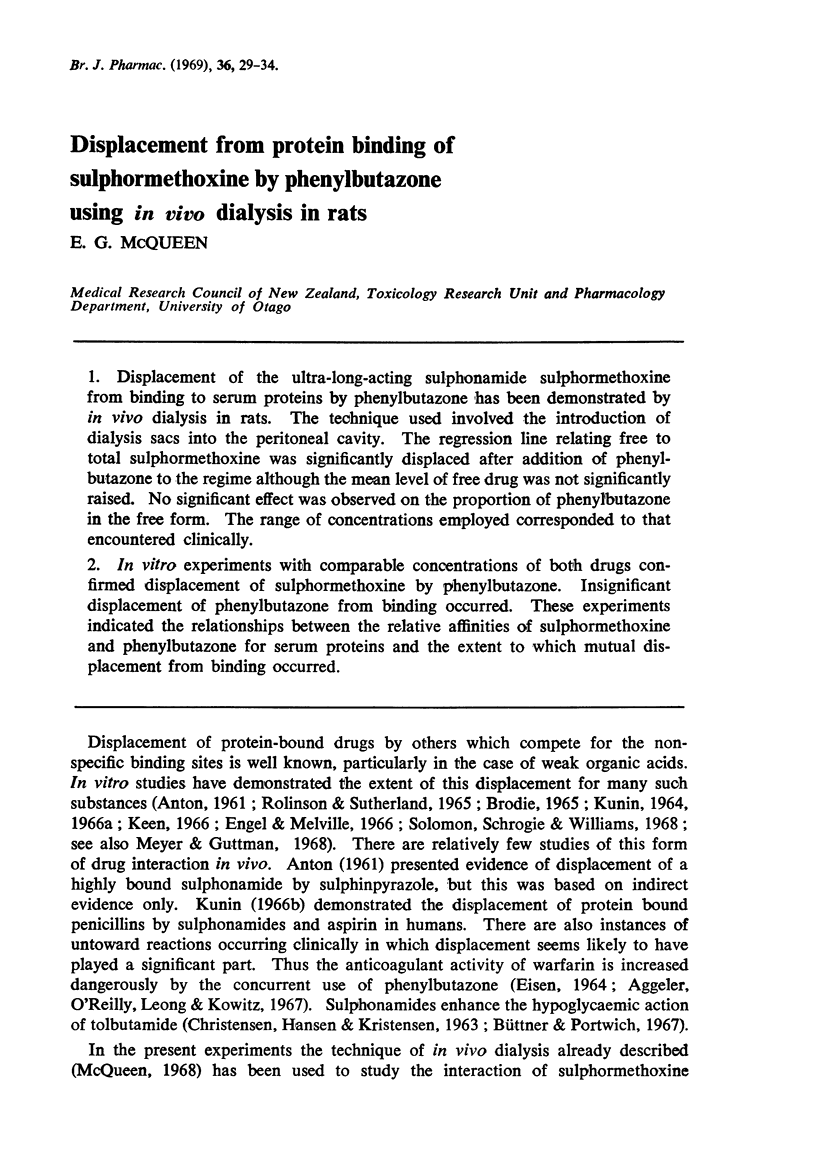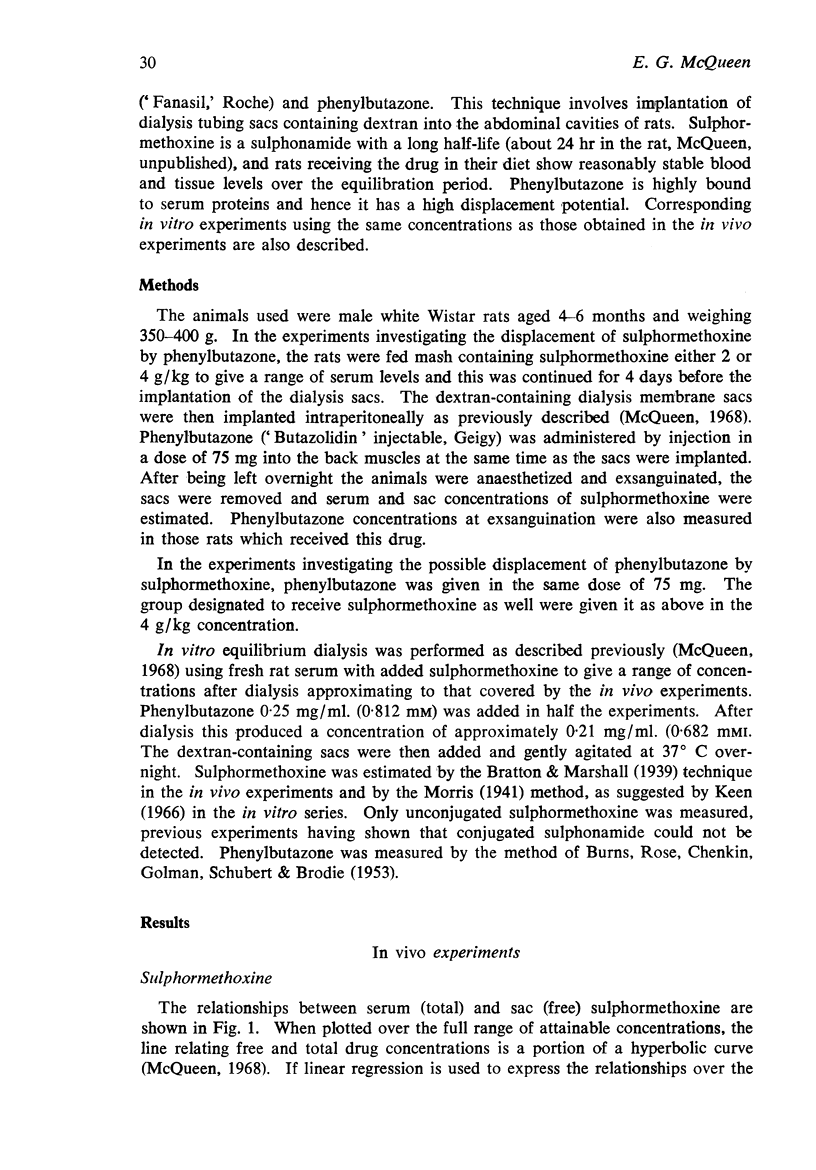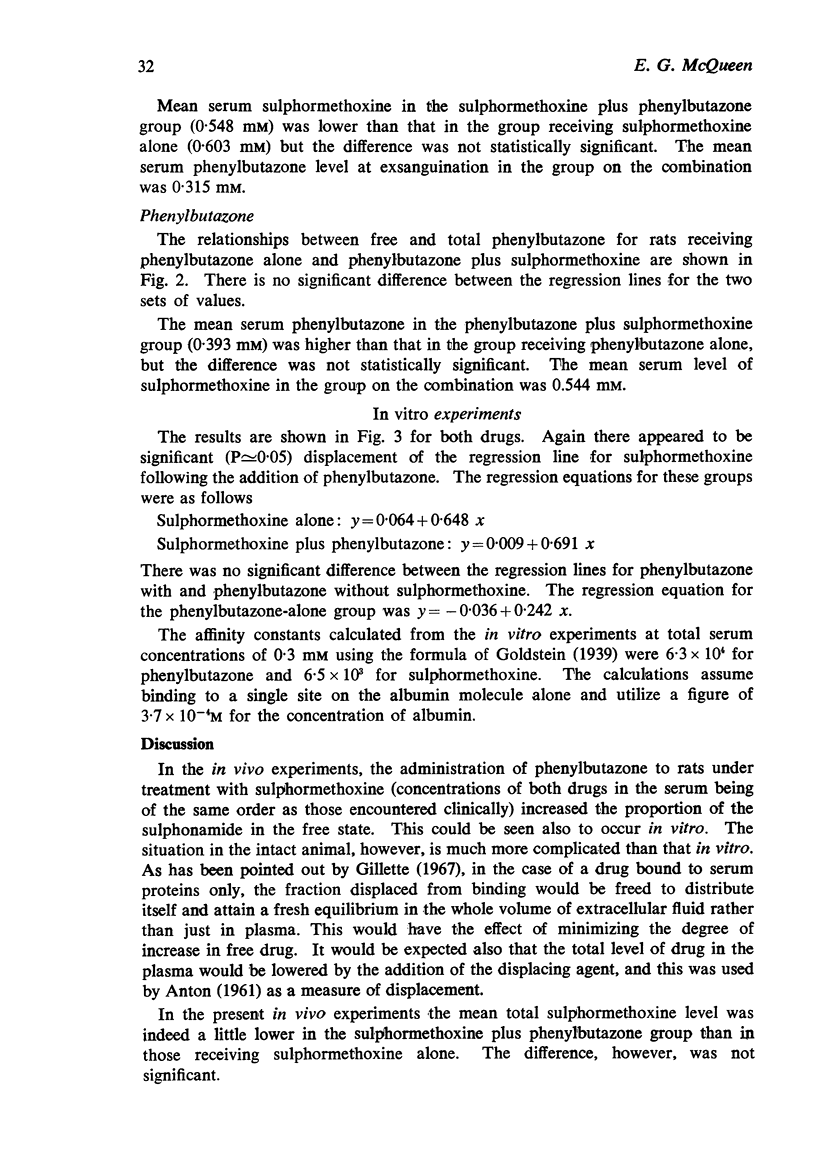Abstract
1. Displacement of the ultra-long-acting sulphonamide sulphormethoxine from binding to serum proteins by phenylbutazone has been demonstrated by in vivo dialysis in rats. The technique used involved the introduction of dialysis sacs into the peritoneal cavity. The regression line relating free to total sulphormethoxine was significantly displaced after addition of phenylbutazone to the regime although the mean level of free drug was not significantly raised. No significant effect was observed on the proportion of phenylbutazone in the free form. The range of concentrations employed corresponded to that encountered clinically.
2. In vitro experiments with comparable concentrations of both drugs confirmed displacement of sulphormethoxine by phenylbutazone. Insignificant displacement of phenylbutazone from binding occurred. These experiments indicated the relationships between the relative affinities of sulphormethoxine and phenylbutazone for serum proteins and the extent to which mutual displacement from binding occurred.
Full text
PDF





Selected References
These references are in PubMed. This may not be the complete list of references from this article.
- ANTON A. H. A drug-induced change in the distribution and renal excretion of sulfonamides. J Pharmacol Exp Ther. 1961 Dec;134:291–303. [PubMed] [Google Scholar]
- Aggeler P. M., O'Reilly R. A., Leong L., Kowitz P. E. Potentiation of anticoagulant effect of warfarin by phenylbutazone. N Engl J Med. 1967 Mar 2;276(9):496–501. doi: 10.1056/NEJM196703022760904. [DOI] [PubMed] [Google Scholar]
- BURNS J. J., ROSE R. K., CHENKIN T., GOLDMAN A., SCHULERT A., BRODIE B. B. The physiological disposition of phenylbutazone (butazolidin) in man and a method for its estimation in biological material. J Pharmacol Exp Ther. 1953 Nov;109(3):346–357. [PubMed] [Google Scholar]
- Brodie B. B. Displacement of one drug by another from carrier or receptor sites. Proc R Soc Med. 1965 Nov;58(11 Pt 2):946–955. doi: 10.1177/003591576505811P202. [DOI] [PMC free article] [PubMed] [Google Scholar]
- Büttner H., Portwich F. Kompetitionsphänomene bei der Bindung von Pharmaka an Albumin. Klin Wochenschr. 1967 Mar 1;45(5):225–230. doi: 10.1007/BF01747600. [DOI] [PubMed] [Google Scholar]
- CHRISTENSEN L. K., HANSEN J. M., KRISTENSEN M. SULPHAPHENAZOLE-INDUCED HYPOGLYCAEMIC ATTACKS IN TOLBUTAMIDE-TREATED DIABETICS. Lancet. 1963 Dec 21;2(7321):1298–1301. doi: 10.1016/s0140-6736(63)90847-x. [DOI] [PubMed] [Google Scholar]
- EISEN M. J. COMBINED EFFECT OF SODIUM WARFARIN AND PHENYLBUTAZONE. JAMA. 1964 Jul 6;189:64–65. doi: 10.1001/jama.1964.03070010070021. [DOI] [PubMed] [Google Scholar]
- KUNIN C. M. ENHANCEMENT OF ANTIMICROBIAL ACTIVITY OF PENICILLINS AND OTHER ANTIBIOTICS IN HUMAN SERUM BY COMPETITIVE SERUM BINDING INHIBITORS. Proc Soc Exp Biol Med. 1964 Oct;117:69–73. doi: 10.3181/00379727-117-29499. [DOI] [PubMed] [Google Scholar]
- Keen P. M. The displacement of three anionic drugs from binding to bovine serum albumin by various anionic compounds. Br J Pharmacol Chemother. 1966 Mar;26(3):704–712. doi: 10.1111/j.1476-5381.1966.tb01850.x. [DOI] [PMC free article] [PubMed] [Google Scholar]
- Kunin C. M. Clinical pharmacology of the new penicillins. 1. The importance of serum protein binding in determining antimicrobial activity and concentration in serum. Clin Pharmacol Ther. 1966 Mar-Apr;7(2):166–179. doi: 10.1002/cpt196672166. [DOI] [PubMed] [Google Scholar]
- Kunin C. M. Clinical pharmacology of the new penicillins. II. Effect of drugs which interfere with binding to serum proteins. Clin Pharmacol Ther. 1966 Mar-Apr;7(2):180–188. doi: 10.1002/cpt196672180. [DOI] [PubMed] [Google Scholar]
- McQueen E. G. Comparison of tissue fluid and plasma concentrations of a protein-bound drug sulphormethoxine by in vivo dialysis in rats. Br J Pharmacol Chemother. 1968 Jun;33(2):312–318. doi: 10.1111/j.1476-5381.1968.tb00992.x. [DOI] [PMC free article] [PubMed] [Google Scholar]
- Meyer M. C., Guttman D. E. The binding of drugs by plasma proteins. J Pharm Sci. 1968 Jun;57(6):895–918. doi: 10.1002/jps.2600570601. [DOI] [PubMed] [Google Scholar]
- Morris C. J. The determination of sulphanilamide and its derivatives. Biochem J. 1941 Sep;35(8-9):952–959. doi: 10.1042/bj0350952. [DOI] [PMC free article] [PubMed] [Google Scholar]
- Rolinson G. N., Sutherland R. The binding of antibiotics to serum proteins. Br J Pharmacol Chemother. 1965 Dec;25(3):638–650. doi: 10.1111/j.1476-5381.1965.tb01788.x. [DOI] [PMC free article] [PubMed] [Google Scholar]
- Solomon H. M., Schrogie J. J., Williams D. The displacement of phenylbutazone-14C and warfarin-14C from human albumin by various drugs and fatty acids. Biochem Pharmacol. 1968 Jan;17(1):143–151. doi: 10.1016/0006-2952(68)90166-4. [DOI] [PubMed] [Google Scholar]


